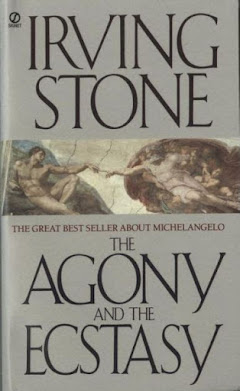The Agony and The Ecstasy - Irving Stone
It's been a while, but this book really pulled me in ,just as much as you would expect. I remember seeing the movie years ago, with Rex Harrison as Pope Julius II and good ol' Charleton Heston as Michelangelo Buonarotti. This book, however, unlike the movie, covers all of Michelangelo's career, from the teenage years as an apprentice onward. The language sets up such a beautiful rhythm, that there are certain portions of the book, where the author is going on and on, and you wouldn't mind if this went on forever. He takes us through the major landmark pieces too, like the David statue and the Sistine Chapel, from concept to finish. The emotional journey of creating work, and all those little love
letters to art-making and the inspiration process, Stone creates those emotions pretty accurately.
Even though this is a historical fiction, it's fun to speculate on the inner workings, and emotional journey of one of these big timers in our culture. Someone who influenced the direction of art for the next several hundred years, as just an enthusiastic start up who sees marble as a living, breathing, organic thing beneath his hands. Usually, such flowery, poetic and cheeseball ways of describing art making are something I roll my eyes at, because the person speaking is usually of mediocre talent and ambition, with an over inflated sense of self-importance due to the high end graphic design, cute little buzz driven types of artistic fluff that gets others to giggle. You know, an artist...
But in the case of Michelangelo Buonarotti, (or at least, Irving Stone's interpretation of the great master's motivations for making, placed in a book designed to be a best seller) I can accept it as a truth of how the inside of a person's head works. Truthfully, we can never really know what kind of psychological path the artist was led down to lead him to the conclusion he presented before us in his art, because if we could comprehend it, we would all do it. The inner workings of the mind of a person like that is always going to be a mystery to us, which is why the work still catches our attention as being above average.
The romanticized version of an artist's life is something that did kind of slow me down while reading this. The portrayal of someone who's choosing to opt out of normal society just so they can make things, that's not really such a romantic thing to do as a person might think. It's not practical in the least, and causes problems with one's social life and overall mental state. That is the sacrifice that you make for creating something that doesn't perform like a weekend hobby. Something that requires large chunks of your time is something that requires large chunks of your time. A commitment is required that means saying no to other things. That saying of "no" will have repercussions, I'm noticing. It's a life of torture that stimulates your creativity. I guess that's how the thing got it's name: "The Agony and the Ecstasy."
A lifestyle that stretches your mind so thin, to the point where its going to snap, but then at the last moment you realize that this is your calling, the Lord's plan for your life, and the way in which you are being stretched is especially designed for you, to reach that deeper part of our humanity that isn't reachable inside the walls of our mainstream society, due to its unexpectedness, its inappropriateness. We are only called upon to access certain parts of our minds through work, school, interaction with friends and family, going to church, watching television, engaging in popular culture, going on dates and having relationships, and all the normal societal behaviors that affect the shape of our lives. There are other parts of our humanity, our being, that are not "taught" or exercised throughout our developmental years. I need a specific string of events to "get me there" as it were, even if I don't immediately know where "there" is.
This is what makes these people feel like a miracle.



